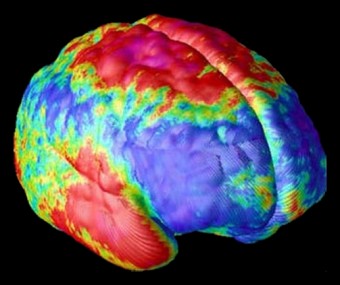Myth: You only use 10% of your brain.
Over the years, the myth that you only use about 10% of your brain has been widely spread with the source of this myth often falsely attributed to Albert Einstein. It turns out though, that every part of the brain gets used, despite what
Hollywood; snake-oil type self help *cough con artists* peddlers; and many others would have you believe.
All other evidence aside, intuitively, if 90% of the brain wasn’t used for anything, then damage to those parts of the brain that comprise that 90% wouldn’t affect a person at all. In reality though, damage to just about any part of the brain, even tiny amounts of damage, tend to have profound effects on the person who suffers that damage.
For more concrete evidence, brain scans, courtesy of Positron Emission Tomography (PET) and Functional Magnetic Resonance Imaging (fMRI) technologies, show us that even while we are sleeping every part of the brain shows at least a small amount of activity and most areas of the brain are active at any given moment, assuming the person being scanned hasn’t ever suffered some form of brain damage. Amazing amounts of research have gone into mapping the brain, in terms of figuring out the function of various parts of the brain, and, to date, no area of the brain has been found that doesn’t have some function, even though that function may not be yet wholly understood.
So where did this myth really come from? There are a few potential sources, though no one knows for sure. Probably the most popularly cited source is Harvard psychologists William James and Boris Sidis with their “reserve energy” theories in the late 19th/early 20th century. “We are making use of only a small part of our possible mental and physical resources”. Sidis even put the theories to practice raising his son, William Sidis, who was a child prodigy and eventually had an estimated IQ of around 250; though Boris Sidis dismissed tests trying to measure intelligence as “silly, pedantic, absurd, and grossly misleading”. The “reserve energy” theory was later summarized, by Lowell Thomas, down to “the average person develops only 10% of their latent mental ability”.
Another theory is that it lies in misinterpretation of neurological research, for instance, when research in the early 20th century indicated that only 10% of the neurons in the brain are firing at any given instant. Alternatively, in that only about 10% of the brain is composed of neurons, with the rest being glial cells, which support and regulate neurons in various ways.
As to why the myth became popular, it’s easy to see why people would be drawn to such a notion. Everybody would love to have it be the case that they naturally only use 10% of their potential brain power. Thus, if they could just magically unlock even a little of the other 90%, they could be the next Albert Einstein or perhaps even develop telekinetic or psychic powers, as is often pushed by Hollywood and others when this myth is mentioned. Even today, numerous self help books and seminars are devoted to trying to help you unlock that mythical other 90%. In the end, you’re better of using that time/money to try to further develop the “10%” you already have. 
Bonus Facts:
- For whatever reason, neurons that handle similar functions tend to cluster together in the brain, thus forming small sections of the brain devoted to certain functions. For instance, the ability for you to see faces and recognize people comes from a specific part of your brain. People who have that part of their brain damaged or its ability diminished in some way often have difficulty recognizing people by their face. In extreme cases, some people can’t see faces at all and, when they look at people, only see a blur or a blank area. This condition is known as prosopagnosia.
- Interestingly, though quite a bit of the brain has been mapped in terms of function, there has yet to be any one area of the brain that handles philosophical consciousness, though there is still quite a bit about how the brain works that is not yet understood.
- Just as interesting is that some “gifted” individuals show less brain activity than “average” people. Some theorize that this is because these gifted people may possess more efficient pathways in their brains, requiring less activity for a given task.
- Williams Sidis, who was son of famed Harvard “reserve energy” psychologist Boris Sidis, could read the New York Times at 18th months old and had learned eight languages (Latin, Greek, French, Russian, German, Hebrew, Turkish, and Armenian) and invented another called Vendergood by the age of eight years old. By the end of his life, he could speak over 40 languages fluently and could pick up enough of a language unknown to him in one day to get by among native speakers.
- Sidis also became the youngest person to enroll in Harvard in 1909 at 11 years old. By 1910, he was giving lectures at Harvard’s Mathematical Club. He earned a B.A. degree by 1914. Unfortunately, Sidis did little with his life when measured against his potential. Early on he tried teaching, but his very young age tended to result in students not listening to him and ganging up and even threatening him at times. He later announced his goal to live a “perfect life”, which to him meant living in complete seclusion; he then more or less accomplished this goal. He died at the age of 46 of a cerebral hemorrhage, which is also what his father died of, but at 56 years old. While in relative seclusion, he wrote a variety of little known works on various subjects including cosmology, American Indian history, anthropology, civil engineering, and a variety of other subjects.
Expand for References:
Read more at http://www.todayifoundout.com/index.php/2010/08/you-actually-use-all-of-your-brain-not-10/#o7oxGRWbJc4xx4XH.99



